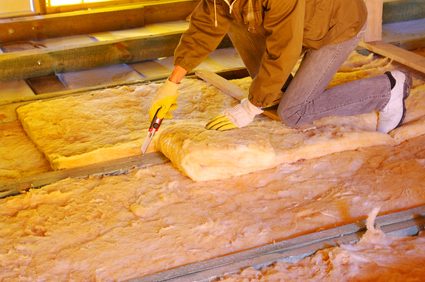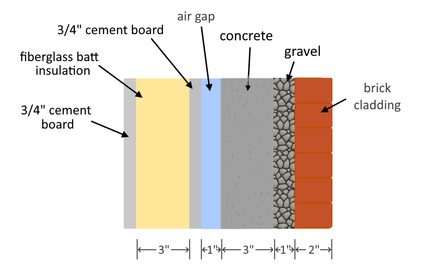Insulation Calculator
This insulation calculator answers the questions:
- What is R-value?
- What is the R-value of a given wall?
- How much insulation do I need?
- How to calculate the R-value (total R-Value) of any wall insulation material, attic insulation, or barrier?
You can play around with this calculator to find out the best combinations of wall insulations that will fit your needs. Select the materials you are already using (or the materials you wish to use), and input their thicknesses to find the total R-value of your barrier.
This is also the perfect time to check out our heat loss calculator, which discusses the "U-Value," which you might want to learn as well. But, to explore this topic of insulation and R-value, keep reading this article.
What is insulation and how much insulation do you need?

Living in places that experience extreme heat during the summer causes people to use air conditioning units to keep their homes comfortable. Our homes' walls, roofs, floors, windows, and exterior doors act as barriers that keep us from the outside temperatures. The materials used for these barriers affect how well our houses keep that intense heat outside. Heat, or thermal energy, flows through materials through conduction, convection, and radiation. We call the materials good at resisting heat flow insulation materials, or insulation.
It is also highly advisable to use insulation for homes that experience freezing temperatures during the winter. Heaters would be much more efficient with insulated walls and roofs since the warmth heaters give out will be properly kept inside. It is also essential to keep a tightly sealed house to avoid heat leakages. Surprisingly, a layer of snow can act as insulation on our roofing. The thicker it is, the more insulated your house is (though it's somewhat dangerous because of the weight of snow on your roof)! However, moisture can build up inside the ceiling and walls without proper roofing and attic insulation, leading to future damage.
🙋 Learn more about the thermodynamics of heat transfer by checking out our heat transfer coefficient calculator.
What is R-value?
Any material that can resist heat flow well can function as insulation (well, even those that are poor resistors can work, but why would you?). R-Value is a numeric value given to a material representing its resistance to heat flow at a given thickness. We can also determine the total R-Value of the layers of material that make up our houses. The higher the R-Value of a barrier is, the higher its thermal resistance is. The thickness of the material also affects its total R-Value. The thicker the material is, the better its thermal resistance is, as long as it has a good R-Value.
On the other hand, getting the reciprocal R-Value provides another factor that describes the thermal flow through a material. We call this factor the U-Value, or the U-coefficient. The U-Value, on the other hand, represents the ability of a material to conduct heat. That means that lower U-values are preferable as they limit the heat flow through the barriers of the house.
How to calculate the R-Value of a barrier
Calculating the total R-Value of a barrier is as simple as adding the R-Value of each material in a given cross-section. Since material R-Values have units in °F·ft²·hr/BTU per unit inch thickness, we first have to multiply the material's R-value by its thickness to obtain its total material R-Value. With that said, we can calculate the total, or bulk, R-Value of a barrier (with multiple layers of materials) using the following equation:
Where Rₙ is the R-Value of a material in °F·ft²·hr/BTU/in, and tₙ is its corresponding thickness in inches. We can also express R-Values in metric or SI units as m²·K/W. We can convert R-Values to RSI (the R-Value in SI units) by dividing the R-Value by the derived constant of 5.6785917.
To further understand how to calculate the R-Value total, let us consider a sample wall with the same layers as the image below:

This sample wall includes typical drywall with 3-inch fiberglass batt wall insulation (R-Value: 3.40) in between two sheets of 3/4" cement board (R-Value: 0.05). This drywall has an air gap (R-Value: 1.43) of 1 inch before coming to a 3-inch concrete wall (R-Value: 0.08). The wall also comes with an exterior 2-inch brick cladding (R-Value: 0.20), with an inch layer of gravel (R-Value:0.60) sandwiched between the concrete and the bricks. Using the table below, we can see what the R-Values for other materials commonly used in building construction are:
Material | R-Value per inch thickness | Material | R-Value per inch thickness |
|---|---|---|---|
Acoustic ceiling tile | 2.90 | Isocyanurate foam | 7.00 |
Air space | 1.43 | Laminated wood fiber board | 2.38 |
Air-entrained concrete | 3.90 | Macerated paper/pulp | 3.57 |
Asbestos cement board | 0.25 | Marble | 0.05 |
Brick (90 PCF) | 0.20 | Marble | 0.09 |
Carpet and fibrous pad | 2.10 | Mineral/rock wool (loose fill) | 3.20 |
Cedar logs | 1.33 | Mineral/rock wool batt | 3.30 |
Cellulose (dense pack) | 3.20 | Particle board (low density) | 1.41 |
Cellulose (loose fill) | 3.50 | Particleboard (med. density) | 1.06 |
Cement board | 0.05 | Particleboard | 1.10 |
Cement mortar | 0.20 | Plywood | 1.25 |
Ceramic tile | 0.08 | PIR polyisocyanurate foam w/ foil | 7.20 |
CMU (hollow) | 1.00 | PIR polyisocyanurate spray foam | 6.50 |
Common brick (120 PCF) | 0.11 | PU polyurethane spray foam (high density) | 6.50 |
Cork board | 3.45 | PU polyurethane spray foam (low density) | 3.70 |
Expanded perlite (loose fill) | 2.63 | Poured concrete | 0.08 |
EPS expanded polystyrene foam | 4.00 | Sand and gravel | 0.60 |
XPS extruded polystyrene foam | 5.00 | Sawdust or shavings | 2.22 |
Fiberglass (dense pack) | 4.00 | Softwood lumber (fir, pine) | 1.25 |
Fiberglass (loose fill) 0.7 PCF | 2.20 | Stucco | 0.20 |
Fiberglass (loose fill) 2.0 PCF | 4.00 | Urea terpolymer foam | 4.48 |
Fiberglass batt (light) | 4.00 | Vermiculite (loose fill) | 2.20 |
Fiberglass batt (standard) | 3.40 | Wood | 1.25 |
Granite | 0.05 | Wood fiber batt | 4.00 |
Gypsum board | 0.90 | Wood shingles | 1.00 |
Hardwood (maple, oak) | 0.91 |
Given the R-Values and the thicknesses of the materials in our example, we can now input them into our insulation calculator, which solves the total R-Value equation, as shown below:
We can then say that the total R-Value of the 11.5-inch wall with the wall insulation described above is 12.948 °F·ft²·hr/BTU, or that it has an R-Value of R-12.9.
Understanding insulation R-Values
The recommended R-Values for each type of barrier we have in our houses depend on where we live. It is also a good practice to check your local building code for their recommended R-Values of your wall insulation, attic insulation, and even floor insulation to know how much insulation you need. You can also see recommended insulation R-Values printed on the insulation packaging. Your local supplier will also be more than happy to tell you the recommended R-Value for the application you need. With the help of our insulation calculator, you can then find the proper thickness of insulation your house needs.
If you find our insulation calculator helpful in determining your wall insulation and attic insulation R-Values, perhaps you might also like to try our air conditioner room size calculator, which will help you determine the appropriate air conditioner size for your room. However, if you're planning to build an energy-efficient house, we highly recommend our passive house savings calculator.